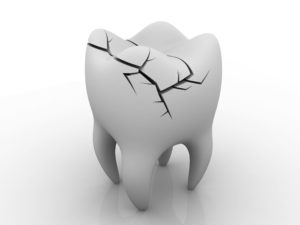“Milk bottle cavities,” or “baby bottle tooth decay” (BBTD), is a condition that results from improper feeding of babies by their parents or caregivers. It is a devastating pattern of decay that causes the teeth to decay all around the gum line. Often, the teeth will even break off at the gum line, causing a disfiguring appearance, pain, and abscessed teeth that must be extracted or have root canal treatment. Replacement of baby teeth is possible but very difficult and expensive, and because children lose baby teeth until age 12, this can lead to years of complications. The eruption of the permanent replacement teeth can also be affected by this condition, so the ramifications can last long past childhood.
The decay sequence involves the sugars in the bottle’s liquid. Although drinks like milk and fruit juice sound healthy and even good for you, they are dangerous when children are put to bed with a bottle. Milk contains lactose sugar and fruit drinks contain fructose sugar. Sugars are eaten by the bacteria on the teeth, which can result in decay. The decay process requires three things: a tooth, plaque, and sugar. So once a child gets a tooth (around six months old) decay can occur.
Three things to keep in mind:
1.) Teeth
Once teeth erupt in the mouth they need to be brushed; that means mom and dad. Letting children play with a toothbrush is good, clean fun and can get them familiar with brushing.
2.) Plaque/Bacteria
The child’s mouth becomes colonized by bacteria from their parents. The bacteria form a sticky adhesive matrix on the teeth that is full of millions and millions of sugar eating bacteria. This is the film that we are removing when we brush and floss.
3.) Sugars
Bacteria live on sugar. Milk has lactose sugar; fruit juices have fructose. Manmade drinks like Gatorade and Hi-C contain various types of sugars. The waste product from bacterial digestion of sugar is acid. The plaque layer of the bacteria holds the acid against the teeth and eats away at the calcium in the outside enamel layer of the tooth. This weakens the tooth’s hardness. Because baby teeth have thinner enamel they decay much more rapidly. Once exposed to sugar, the bacteria make acid for twenty minutes.
What makes nighttime bottles so dangerous is the length of time the teeth are bathed in sugar and therefore acid. Compounding the effects of the acid is the fact that saliva flow decreases at night and plaque grows much more rapidly during sleep. Therefore, the maximum acid production occurs when the bacteria are most plentiful.
Conclusion
We all want to be great parents, and we certainly don’t want to be responsible for causing prolonged pain and anguish to our children. Prevention of “baby bottle tooth decay” is simple. Give your little one only water at sleep time.
 X-rays play an invaluable role in detecting complications with your teeth, such as areas of decay. Unfortunately, there are some issues that may not show up on the images, like tiny cracks. When they are too small to see on an x-ray, it is known as cracked tooth syndrome. The fractures can develop above or below the gum line. No matter where they occur, you will need treatment for cracked tooth syndrome in Tallahassee.
X-rays play an invaluable role in detecting complications with your teeth, such as areas of decay. Unfortunately, there are some issues that may not show up on the images, like tiny cracks. When they are too small to see on an x-ray, it is known as cracked tooth syndrome. The fractures can develop above or below the gum line. No matter where they occur, you will need treatment for cracked tooth syndrome in Tallahassee.